Xenotime, Y[PO4], Tetragonal, I41/amd
< Specimens No. VIII-1—No. VIII-5 >
Specimens No. VIII-1—No. VIII-5, from the Ishikawa District, Fukushima
Pref., occur in a granitic pegmatite with quartz, orthoclase, biotite and
small amounts of zircon and monazite. The crystals of xenotime are in pale
brown octahedra with z(111), and sometimes show parallel growth with zircon
in the direction of the c-axis. The largest crystal is 1 cm long along the
edge (Figs. 87, & 88).
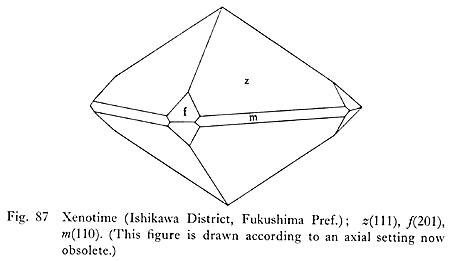

Monazite, Ce[PO4], Monoclinic, P21/n
< Specimens No. VIII-6—No. VIII-9 >
Specimens No. VIII-6—No. VIII-8, from the Ishikawa District,
Fukushima Pref., occur in a granitic pegmatite as yellowish brown to brown
and tabular or prismatic crystals attaining 2 cm in length. On the isolated
crystals, a(100), m(110), b(010) and x(![]() 01)
are well-developed (Fig. 89). Specimen No. VIII-6 shows twinning on a(100).
01)
are well-developed (Fig. 89). Specimen No. VIII-6 shows twinning on a(100).
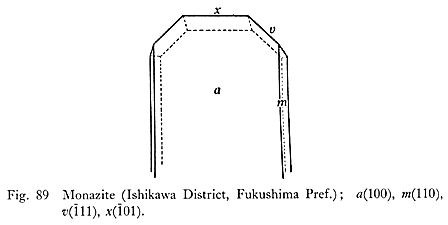
Specimen No. VIII-9, from Daisen, Fukuoka Pref., is small yellowish granular crystals, about 2 mm across, in a granitic pegmatite, and associated with tourmaline and andalusite.
Apatite, Ca5[F|(PO4)3], Hexagonal, P63/m
< Specimens No. VIII-10—No. VIII-28 >
Specimens No. VIII-10—No. VIII-12, from Kanayamazawa of the Arakawa
Mine, Akita Pref., occur on needle-shaped crystals of quartz in drusy
cavities in a chalcopyrite-pyrite-hematite-chlorite-quartz vein. The crystals
are in hexagonal short prisms with c(0001), x(10![]() 1)
and m(10
1)
and m(10![]() 0). They are white in
colour, transparent to translucent, and a few millimeters in diameter.
0). They are white in
colour, transparent to translucent, and a few millimeters in diameter.
Specimens No. VIII-13—No. VIII-22, from the Ashio Mine, Tochigi
Pref., occur in drusy cavities of chalcopyrite ores in a hydrothermal replacement
copper deposit, so-called " Kajika deposit". Apatite forms hexagonal tabular
crystals terminated by the bases. They are white in colour and transparent
to translucent. Their main faces are c(0001), x(10![]() 1),
s(11
1),
s(11![]() 1) and m(10
1) and m(10![]() 0).
Sometimes, small hexagonal tabular or prismatic crystals form aggregates in
subparallel growth in the direction of the main axis as in specimen No. VIII-16
(Plate 13, Figs. 90 & 91).
0).
Sometimes, small hexagonal tabular or prismatic crystals form aggregates in
subparallel growth in the direction of the main axis as in specimen No. VIII-16
(Plate 13, Figs. 90 & 91).
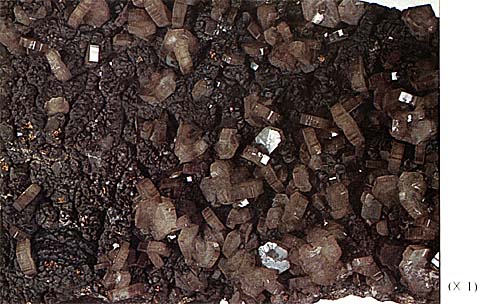
APATITE (No. VIII-22) Ashio Mine, Tochigi Pref.
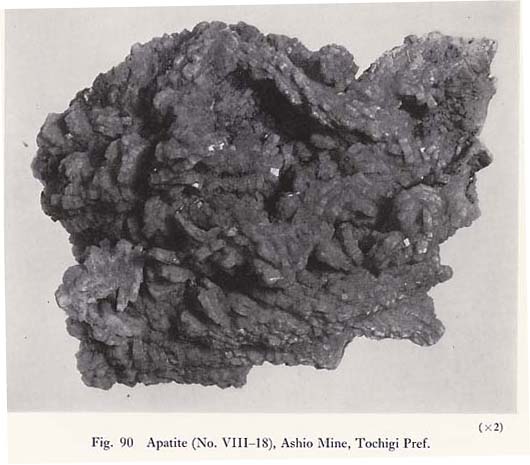
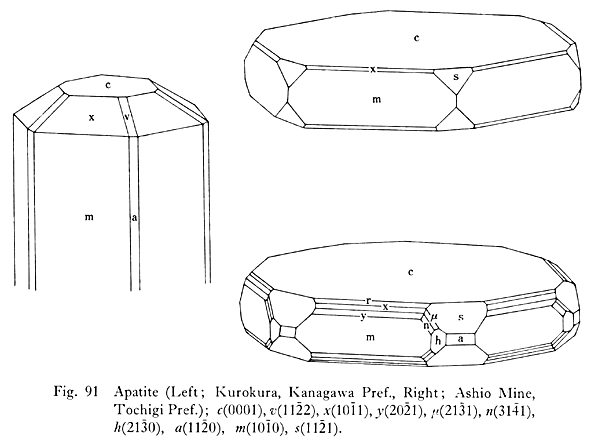
Specimens No. VIII-23—No. VIII-26, from Uzunosawa, Nakatsugawa,
Saitama Pref., occur in drusy cavities in magnetite ores, associated with
andradite and diopside, in a contact metasomatosed iron deposit. Apatite forms
hexagonal short prismatic crystals with c(0001), x(10![]() 1)
a(11
1)
a(11![]() 0) and m(10
0) and m(10![]() 0),
attaining 3 cm in length, white to pale yellow and transparent to translucent.
0),
attaining 3 cm in length, white to pale yellow and transparent to translucent.
Specimens Nos. VIII-27 & VIII-28, from Kurokura, Kanagawa Pref., occur
in druses in a quartz vein cutting through granodiorite, form short columnar
crystals terminated by the bases, and are discoloured in white near the surface
but clear near the centre. They are up to 35 mm in length. Faces observed
are m(10![]() 0), a(11
0), a(11![]() 0),
v(11
0),
v(11![]() 2), x(10
2), x(10![]() 1)
and c(0001) (Fig. 91).
1)
and c(0001) (Fig. 91).
Pyromorphite, Pb5,[Cl(PO)4]3, Hexagonal, P63/m
< Specimens No. VIII-29—No. VIII-44 >
Specimens No. VIII-29—No. VIII-31, from the Hisaichi Mine, Akita Pref., occur on crystalline quartz in cavities or fractures of a pyrite-chlorite-quartz vein in a weathered zone, and form groups of hexagonal prismatic or acicular crystals, measuring about 5 mm long. They are pale yellowish green to pale brown and transparent.
Specimens No. VIII-32—No. VIII-37, from the Kisamori Mine, Akita
Pref., occur in fractures of an oxidized ore in an epithermal copper-lead-zinc
deposit. The crystals form olive-green hexagonal prisms terminated by the
bases, and reach 1 cm in length (Fig. 92).
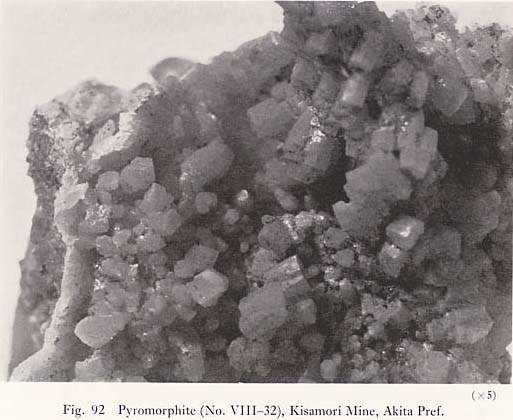
Specimens Nos. VIII-38 & VIII-39, from the Chomatsu Mine, Fukushima Pref., occur as secondary mineral in an oxidized copper-lead-zinc ore. The crystals are yellowish green and hexagonal prismatic, up to 1 mm in length, and with a barrel-shape habit.
Specimen No. VIII-40, from the Ogoya Mine, Ishikawa Pref., occurs as secondary mineral in fractures of a rhyolitic rock in an epithermal copper-lead-zinc deposit. Pyromorphite forms acicular to prismatic crystals up to 5 mm in length and pale brown in colour.
Specimen No. VIII-41, from the Kamioka Mine, Gifu Pref., occurs as secondary mineral in a weathered zone of a contact metasomatosed lead-zinc deposit. The crystals are in small hexagonal prisms measuring a few millimeters in and length light green to light yellow in colour.
Specimen No. VIII-42, from the Mozumi Deposit of the Kamioka Mine, Gifu Pref., is a secondary mineral in fractures of a weathered lead-zinc ore from a contact metasomatosed deposit. The crystals are in hexagonal short prisms up to 5 mm in length and of barrel-like shape.
Specimen No. VIII-43, from the Ongiin Mine, Korea, occurs as secondary
product in fractures of a gold-silver-quartz vein in a weathered zone, and
forms yellowish green acicular to prismatic crystals with c(0001) and m(10![]() 0).
0).
Specimen No. VIII-44, from Germany, occurs in a cavity in an oxidized leadore. The crystals form a group of short hexagonal prisms grey to brownish grey in colour.
Vanadinite, Pb5[Cl|(VO4)3], Hexagonal, P63/m
< Specimen No. VIII-45 >
Specimen No. VIII-45, from Algeria, is a secondary mineral occurring in a weathered zone of a lead ore deposit. It forms hexagonal short prismatic crystals in deep reddish orange colour.
Scorodite, Fe3+[AsO4]·2H2O, Rhombic, Pcab
< Specimens No. VIII-46—No. VIII-48 >
Specimens No, VIII-46—No. VIII-48, from the Kiura Mine, Oita
Pref., occur as secondary mineral in fractures of an arsenopyrite-quartz vein,
forming greenish grey and transparent octahedral crystals up to 1 cm in diameter.
The dominant face is p(111), and other faces observed are c(001), d(120) and
g(011) (Plate 13, Figs. 93 & 94).
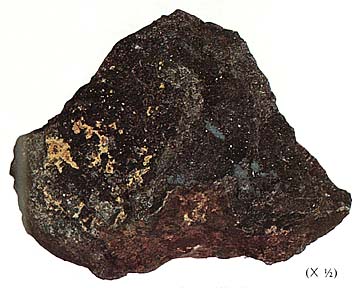
SCORODlTE (No. VIII-48) Kiura Mine, Oita Pref.
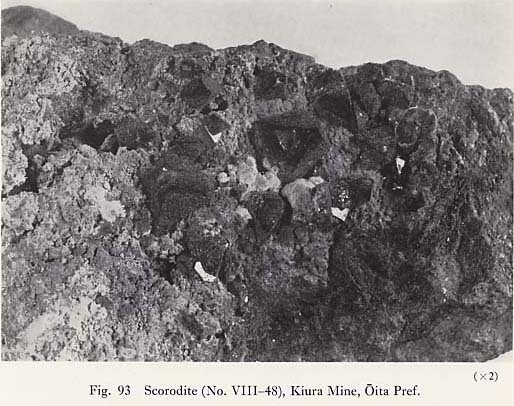
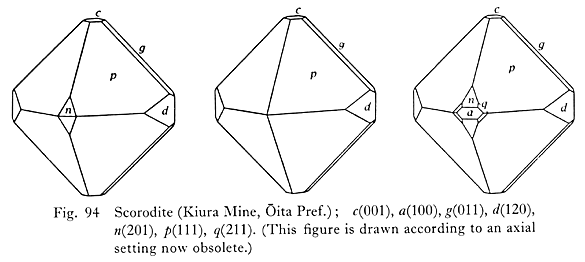
Ludlamite, Fe32+[PO4]2·4H2O, Monoclinic, P21/c
< Specimen No. VIII-49 >
Specimen No. VIII-49, from the Ashio Mine, Tochigi Pref., occurs as secondary mineral intimately associated with vivianite in fractures in the country rock of a hydrothermal copper deposit. It is pale green and transparent massive aggregates.
Vivianite, Fe32+[PO4]2·8H2O, Monoclinic, C2/m
< Specimens No. VIII—50-No. VIII-65 >
Specimens No. VIII-50—No. VIII-65, from the Ashio Mine, Tochigi
Pref., occur in fractures or drusy cavities of chalcopyrite ores from a hydrothermal
replacement copper deposit. They form groups of prismatic or tabular crystals
about 8 cm long and 1 cm wide. The form common among the crystals is the combination
of a(100),m(110), b(010) and v(![]() 11),
b(010) being the plane of perfect cleavage (Plate 13, Fig. 95).
11),
b(010) being the plane of perfect cleavage (Plate 13, Fig. 95).
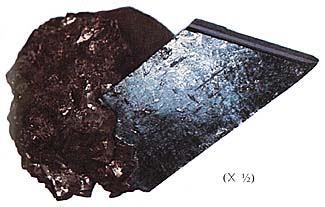
VIVIANITE (No. VIII-61) Ashio Mine, Tochigi Pref.
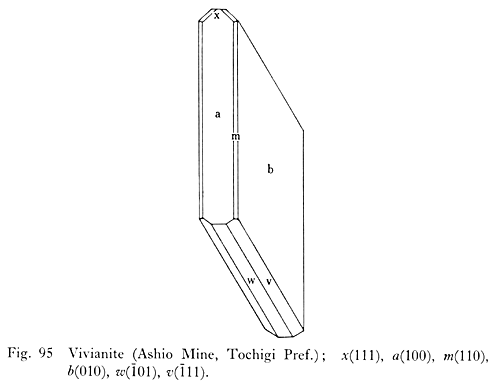
Parasymplesite, Fe32+[AsO4]2·8Hg2O, Monoclinic, C2/m
< Specimen No. VIII-66 >
Specimen No. VIII-66, from the Kiura Mine, Oita Pref., occurs as secondary
mineral in cavities in an arsenopyrite-quartz vein, and forms groups of small
crystals ith the dominant faces of b(010), w(![]() 01),
m(110), e(
01),
m(110), e(![]() 02) and t(
02) and t(![]() 01),
dark greenish blue and up to about 3 mm in diameter (Plate 13).
01),
dark greenish blue and up to about 3 mm in diameter (Plate 13).
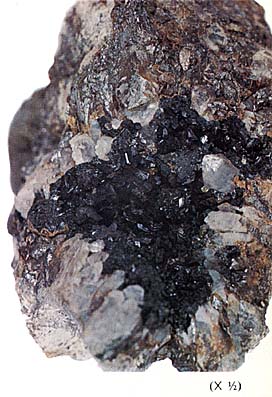
PARASYMPLESITE (No.VIII-66) Kiura Mine, Oita Pref.
Erythrite, Co3[AsO4]2·8H2O, Monoclinic, C2/m
< Specimens Nos. VIII-67 & VIII-68 >
Specimen No. VIII-67, from Chile, forms light reddish purple coloured thin incrustations on a cobalitite-bearing sulphide ore.
Specimen No. VIII-68, from the Chiksan Mine, Korea, occurs as secondary mineral of a l????llingite ore bearing a small amount of cobaltite, and forms thin crustal aggregates of minute acicular crystals, sometimes with a radial texture. It is vivid red purple in colour.
Veszelyite (Arakawaite), (Cu, Zn)3[(OH )3|PO4]·2H2O, Monoclinic, P21/a
< Specimens No. VIII-69—No. VIII-120 >
Specimens No. VIII-69—No. VIII-116 are from the Hisaichi Mine,
Akita Pref. "Arakawaite " has been identified as veszelyite from its crystal
structure, chemical composition (Cu : Zn ![]() 2 : 1) and other properties. Veszelyite in these specimens is a secondary
mineral from an oxidized copper ores bearing lead and zinc. It forms incrustations
or groups of crystals with prismatic or stout and flat prismatic habit, reaching
1 cm in diameter. It is dark bluish green to deep green in colour. The dominant
faces are e(011), m(110) and i(
2 : 1) and other properties. Veszelyite in these specimens is a secondary
mineral from an oxidized copper ores bearing lead and zinc. It forms incrustations
or groups of crystals with prismatic or stout and flat prismatic habit, reaching
1 cm in diameter. It is dark bluish green to deep green in colour. The dominant
faces are e(011), m(110) and i(![]() 11).
Common associated minerals are hemimorphite, malachite, cerussite, linarite,
chrysocolla and limonite. The crystals of veszelyite are often replaced by
pseudomalachite and hidalgoite such as in specimens No. VIII-105, No. VIII-107
and No. VIII-114. The replacement by the former results in a pseudomorph after
veszelytie and in green aggregates. On the other hand, the replacement by
the latter produces aggregates of nile-blue thin crystals after dissolution
of veszelyite crystals (Plate 2, Fig. 96).
11).
Common associated minerals are hemimorphite, malachite, cerussite, linarite,
chrysocolla and limonite. The crystals of veszelyite are often replaced by
pseudomalachite and hidalgoite such as in specimens No. VIII-105, No. VIII-107
and No. VIII-114. The replacement by the former results in a pseudomorph after
veszelytie and in green aggregates. On the other hand, the replacement by
the latter produces aggregates of nile-blue thin crystals after dissolution
of veszelyite crystals (Plate 2, Fig. 96).

VESZELYITE ("ARAKAWA1TE") and PSEUDOMALACHITE (No. VIII-100) Hisaichi Mine,
Akita Pref.
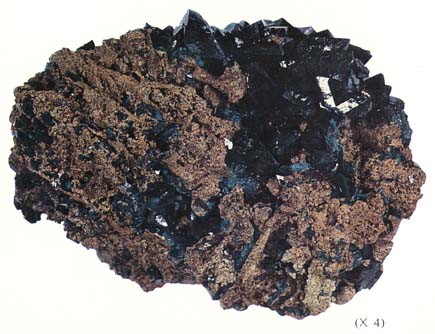
VESZELYITE("ARAKAWAITE") (NO.VIII-113) Hisaichi Mine, A kita Pref.
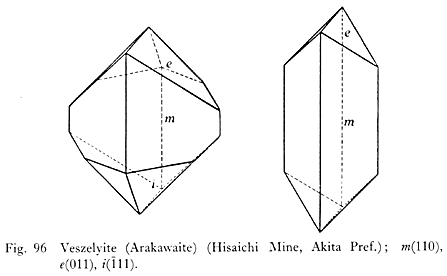
Specimens No. VIII-117—No. VIII-120, are from the Sugisawa Mine, Akita Pref., and in the same sequence as veszelyite in specimens No. VIII-69—No. VIII-116 from the Hisaichi Mine.
Aluminum-phosphate, Cryptocrystalline
< Specimen No. VIII-121 >
Specimen No. VIII-121, from the Ashio Mine, Tochigi Pref., occurs in fractures in a chalcopyrite ore associated with apatite, and forms pale-yellow, transparent and botryoidal aggregates with glassy luster. This was believed to be a mixture of fischerite and fluellite from its chemical composition: P2O5, 25.13; Al2O3, 36.07; AlF3, 12.55; Fe2O3, 0.31; H2O(+), 26.94, (analysis by the Ashio Mine), but it shows an amorphous pattern in X-ray diffraction.
Carnotite, K2[(UO2)2|V2O8]·3H2O, Monoclinic, P21/a
< Specimens No. VIII-122—No. VIII-125 >
Specimens No. VIII-122—No. VIII-125 from Colorado, U.S.A., occur as secondary mineral in sandstone, forming bright yellow coloured earthy disseminations or films.